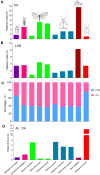Brain Organization of Apolygus lucorum: A Hemipteran Species With Prominent Antennal Lobes
- PMID: 31379518
- PMCID: PMC6654032
- DOI: 10.3389/fnana.2019.00070
Brain Organization of Apolygus lucorum: A Hemipteran Species With Prominent Antennal Lobes
Abstract
The anatomical organization of distinct regions in the insect brain often reflects their functions. In the present study, the brain structure of Apolygus lucorum was examined by using immunolabeling and three-dimensional reconstruction. The results revealed the location and volume of prominent neuropils, such as the antennal lobes (AL), optic lobes (OL), anterior optic tubercles (AOTU), central body (CB), lateral accessory lobes (LAL), mushroom lobes, and distinct tritocerebral neuropils. As expected, this brain is similar to that of other insects. One exception, however, is that the antennal lobes were found to be the most prominent neuropils. Their size relative to the entire brain is the largest among all insect species studied so far. In contrast, the calyx, a region getting direct input from the antennal lobe, has a smaller size relative to the brain than that of other species. These findings may suggest that olfaction plays an essential role for A. lucorum.
Keywords: Apolygus lucorum; anatomy; antennal lobe; brain; neuropil.
Figures








References
-
- Anton S., Homberg U. (1999). “Antennal lobe structure,” in Insect Olfaction, ed. Hansson B. S. (Berlin: Springer; ), 97–124.
LinkOut - more resources
Full Text Sources
Research Materials

